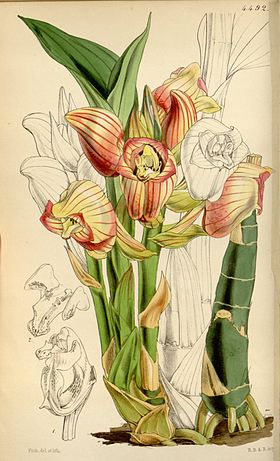Acanthephippium
| Acanthephippium | |||||||||||||||
|---|---|---|---|---|---|---|---|---|---|---|---|---|---|---|---|
| Classificação científica | |||||||||||||||
| |||||||||||||||
| Espécies | |||||||||||||||
Acanthephippium é um género botânico pertencente à família das orquídeas (Orchidaceae).
A autoridade científica do género é Blume ex Endl., tendo sido publicado em Genera Plantarum 200. 1837.[1]
É um género com doze espécies monopodiais e epífitas da subtribo Sarcanthinae. Estas orquídeas são terrestres e por vezes saprofíticas com hábito de desenvolvimento simpodial.
Etimologia
[editar | editar código-fonte]"Acanthephippium" deriva das palavras gregas: "acanthos" = "espinhoso" e "ephippion" = "sillín" "assento" - referindo-se à estrutura do labelo que assemelha a un selim.
Habitat
[editar | editar código-fonte]Estas espécies simpodiais distribuem-se em zonas tropicais e subtropicais, desde a Índia, até à China e por Sul até à Malásia, Indonésia e Nova Guiné.
Descrição
[editar | editar código-fonte]Estas orquídeas terrestres alcançam uma altura de 80 cm. Têm rizomas curtos. Os oblongos e erectos pseudobulbos alcançam 25 cm de altura. Produzem 3 a 4 grandes folhas lanceoladas com nervuras paralelas, que alcançam um comprimento de 65 cm.
A inflorescência, erecta, sai lateralmente dos pseudobulbos, com 3 a 6 flores e rodeada de grandes brácteas glabras. As flores são grandes, com cerca de 4 cm, estriadas e em forma de urna ou taça, carnosas. Seu aspecto recorda uma tulipa, forma totalmente inusual numa orquídea.
As flores têm uma ampla gama de cores, desde um amarelo pálido a vermelho com sombras laranjas ou rosas e marcas em forma de raios ou pontos.
A floração liberta odores com uma forte fragrância.
A coluna é curta e carnosa, tendo dois polínios.
Este género é próximo dos géneros Calanthe, Phaius e Spathoglottis.
Espécies
[editar | editar código-fonte]O gênero Acanthephippium possui 13 espécies reconhecidas atualmente.[2]
- Acanthephippium bicolor Lindl.
- Acanthephippium chrysoglossum Schltr.
- Acanthephippium curtisii Rchb.f.
- Acanthephippium eburneum Kraenzl.
- Acanthephippium gougahensis (Guillaumin) Seidenf.
- Acanthephippium javanicum Blume
- Acanthephippium lilacinum J.J.Wood & C.L.Chan
- Acanthephippium mantinianum L.Linden & Cogn.
- Acanthephippium parviflorum Hassk.
- Acanthephippium pictum Fukuy.
- Acanthephippium splendidum J.J.Sm.
- Acanthephippium striatum Lindl.
- Acanthephippium sylhetense Lindl.
Ver também
[editar | editar código-fonte]Ligações externas
[editar | editar código-fonte]Referências
- ↑ Tropicos.org. Missouri Botanical Garden. 06 Jan 2015 <http://www.tropicos.org/Name/40003172>
- ↑ «Acanthephippium» (em inglês). The Plant List. 2010. Consultado em 22 de julho de 2016
Bibliografia
[editar | editar código-fonte]- Leroy-Terquem, Gerald and Jean Parisot. Orchids: Care and Cultivation. London: Cassel Publishers Ltd., 1991.
- Schoser, Gustav. Orchid Growing Basics. New York: Sterling Publishing Co., Inc., 1993.
- White, Judy. Taylor’s Guide to Orchids. Frances Tenenbaum, Series Editor. New York: Houghton-Mifflin, 1996.
- The Illustrated Encyclopedia of Orchids by Alec Pridgeon. Published by the Timber Press.
- The Manual Of Cultivated Orchid Species By Bechtel, Cribb and Launert, Published by The MIT Press.
- Thomas, S.A. 1997 - Taxonomic revision of the genus Acanthephippium (Orchidaceae). Orchid Monographs, Vol. 8, pp. 119–134, figures 56-66, plates 5c-6d. Rijksherbarium / Hortus Botanicus, Leiden, The Netherlands.
Text is available under the CC BY-SA 4.0 license; additional terms may apply.
Images, videos and audio are available under their respective licenses.


